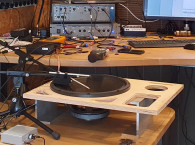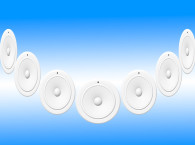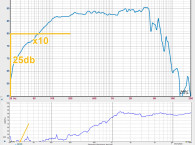
Solutions to these problems are known. The most expensive solution is an anechoic chamber. However, at low frequencies these chambers need to have extremely large dimensions. A frequency of 20Hz correspond to 17m wavelength and absorbers are effective up to a quarter wavelength from the boundaries. That is the reason why most anechoic chambers have a lower corner frequency of around 70Hz.
Alternative techniques, such as quasi-anechoic measurements, using a ground plane, impulse testing, MLS testing and Log-Swept Sine measurements, are also well known. In 2000, Farina introduced the Log-Swept Sine measurement [1]. Today, it is the most used technique for loudspeaker testing, as it shows a good dynamic range and allows the simultaneous measurement of frequency response and harmonic distortions. A theoretical and experimental comparison of several techniques can be found in a 2002 Journal of the Audio Engineering Society article written by G. Stan, J. Embrechts, and D. Archembeau [2].
For a standard laboratory environment, the Log-Swept Sine technique needs to be combined with time gating of the measurement signal. Otherwise, reflections from hard boundaries, room resonances, and ambient noise would significantly impact the accuracy of the results.
However, time gating tackles mainly the first challenge. Sufficient short time windows limit the resolution of the frequency measurement. The time-bandwidth uncertainty [3] gives the frequency resolution as the inverse of the time window duration. In simple terms: When one wants to measure a frequency of 1Hz, one needs to measure for a time duration of 1 second. Also, windowing may truncate the impulse response before it has decayed to a sufficiently low level.
Most lab rooms with the usual distances from the device under test to the walls, ceiling, or floor generate reflections within 10ms. A time window set to 10ms limits the frequency resolution to 100Hz. Measurements down to 20Hz with a sufficient frequency resolution are impossible.
It is therefore sensible to find a solution to increase the time window to say 10s and solve simultaneously the second and third challenge. Such a solution needs to work in the time domain before applying the time window respectively the Short-Term Fourier Transformation (STFT). This article will describe a technique we developed to solve these difficulties.
The Technique
The basic idea is to perform a near-field measurement with two identical microphones. A Measurement microphone is positioned close (say 5cm distance) from the loudspeaker membrane and a Mode microphone is positioned at a short distance (say 5cm) from the measurement microphone along an axis perpendicular to the loudspeaker. Photo 1 shows the geometry for two microelectromechanical systems (MEMS) microphones.
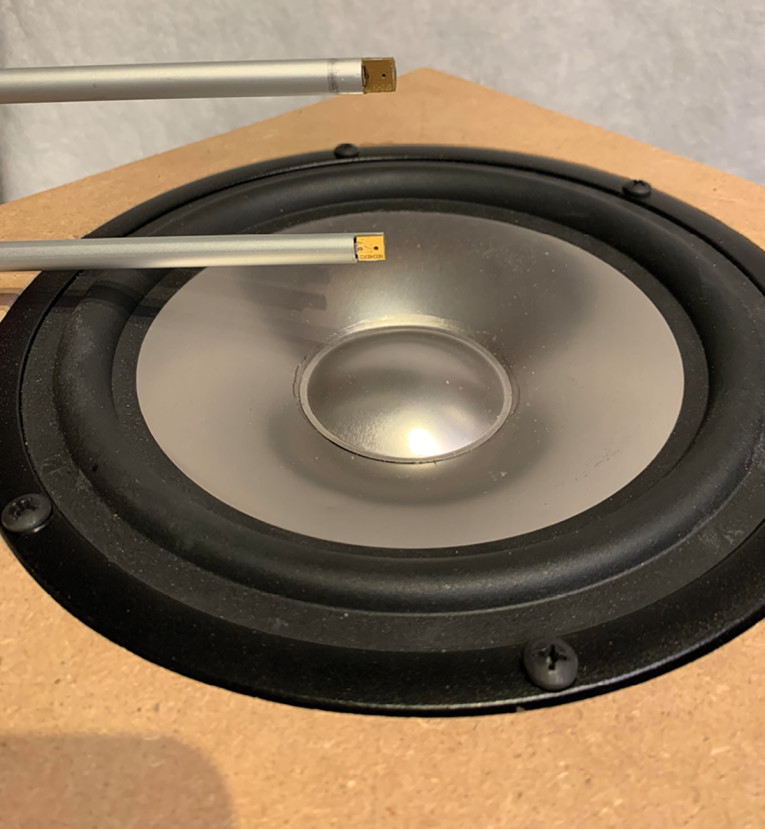
Both microphones record the sound pressure from the loudspeaker. The upper Mode microphone will record a lower level than the lower measurement microphone according to the one over distance law.
Both microphones record room modes, reflections, and ambient noise at nearly equal level, as those sound sources are relatively far away from both microphones. Subtraction of the recorded signals in the time domain eliminates (or reduces to an insignificant level) the room influence on the measurement.
Practical Measurements
The graph shown in Figure 1 shows typical frequency responses measured with this setup. The measurement microphone was located about 5cm from the membrane and the mode microphone was located exactly 5cm from the measurement microphone.

This measurement technique solves all the three previously mentioned challenges. By subtraction of the two signals in the time domain, reflections and room modes are cancelled and as both microphones receive the ambient noise with equal level, that ambient noise is cancelled too. This results in a significant increase in measurement dynamics, especially at low frequencies.
Without reflections and room modes present in the time domain signal, the time window for the STFT can be freely set (e.g., to 10s corresponding to 0.1Hz frequency resolution). The graphs used in this article have been recorded using our ModeCompensator measurement test set (see Photo 2). The ModeCompensator comprises two calibrated MEMS microphones and the necessary electronics to perform the Time Domain subtraction and nulling of the signals.

The time domain signal subtraction is illustrated in Figure 2. The ModeCompensator adjustment dial is adjusted until the room modes become invisible. The inversion of their phases at this point is a clear and accurate indicator.

Two microphones at approximately 5cm generate a comb filter frequency response as shown in Figure 3. In Figure 3a, the combined frequency response of the two microphones is shown in blue. The subtraction causes a 6dB loss at low frequencies due to the one-over-distance law and the chosen distances. The distance between the microphones leads to a frequency proportional phase shift.
Thus, at higher frequencies, the subtractions turns into an addition resulting in a level increase with frequency. That frequency response can be corrected in the time domain by an inverse low-pass filter (red). The resulting frequency response (green) is accurate up to 1000Hz. Figure 3b shows a closer look to the inverse low-pass filter. Finally, Figure 3c shows a close look at the resulting frequency response. It is accurate within +0 to -0.1dB up to 1000Hz.
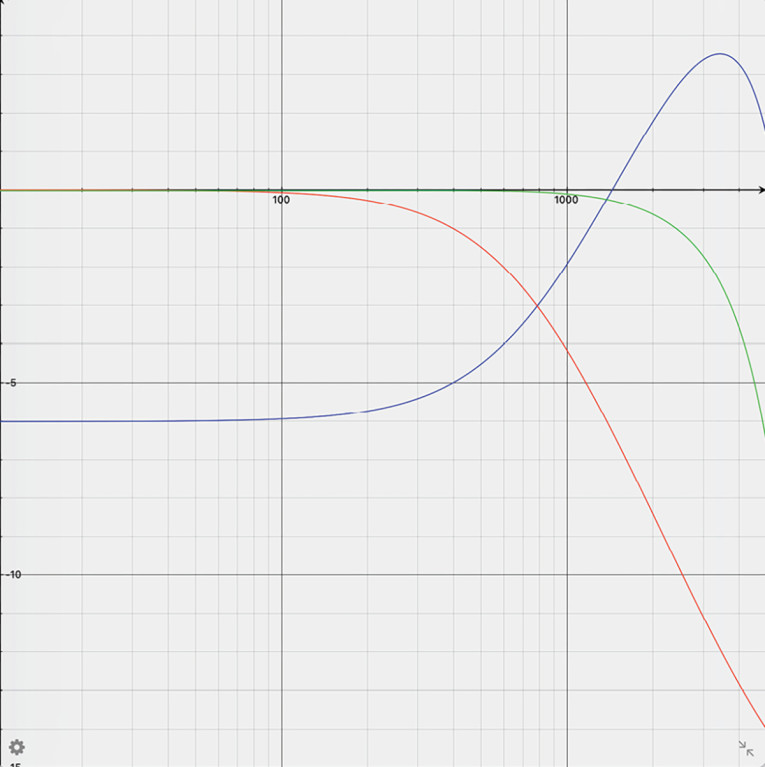


The Method
The measurement technique presented here can be performed easily with two identical microphones, a dual input audio interface and software to perform logarithmic sweep measurements. However, such a setup will usually not allow the necessary inverse filtering as shown in Figure 3. Therefore, AudioChiemgau has developed an affordable ModeCompensator comprising two calibrated MEMS microphones and the necessary electronics to perform the tasks as shown in Photo 1.
Figure 4 shows a block diagram of the ModeCompensator. A user guide with further details can be downloaded from the AudioChiemgau website. www.AudioChiemgau.de

Christopher Struck and Steve Temme presented a method whereby the full-range frequency response of a loudspeaker is measured by combining its separately measured low-frequency response with its mid and high- frequency response [4]. Our Mode Compensation technique now enlarges the frequency range of the near field measurement down to 10Hz with 0.1Hz frequency resolution, only limited by the microphones used. As shown in Figure 3 the upper frequency limit is determined by the distance of the two microphones and reaches 1kHz at 0.1dB accuracy.
Summary
Appropriate signal processing in the time domain enables users to overcome the well-known limitations of time gated near-field measurements. With two microphones at defined distances to the loudspeaker membrane and difference building in the time domain before applying the time window/STFT, accurate measurements of the frequency response of the sound pressure level and harmonic distortion become possible in a standard lab environment. Level resolutions of 0.1dB and a frequency resolution of 0.1Hz can easily be achieved between 10Hz and 1kHz. In addition, the suppression of ambient noise results in a high measurement dynamic range required for the measurement of low-level harmonic distortions. aX
References
[1] A. Farina, “Simultaneous measurement of impulse response and distortion with a swept sine technique,” presented at the 108th Audio Engineering Society (AES) Convention, Paris, France, 2000.
[2] G. Stan, J. Embrechts, and D. Archembeau, “Comparison of Different Impulse Measurement Techniques,” Journal of the Audio Engineering Society (JAES) Volume 50, No. 4, 2002.
[3] R. Hoffmann, “Grundlagen der Frequenzanalyse, Eine Einführung für Ingenieure und Informatiker,“ 2. Auflage, Expert Verlag, Renningen 2005.
[4] C. Struck and S. Temme, “Simulated Free Field Measurements,” presented at the 93rd Audio Engineering Society (AES) Convention, 1992.
This article was originally published in audioXpress, October 2023



